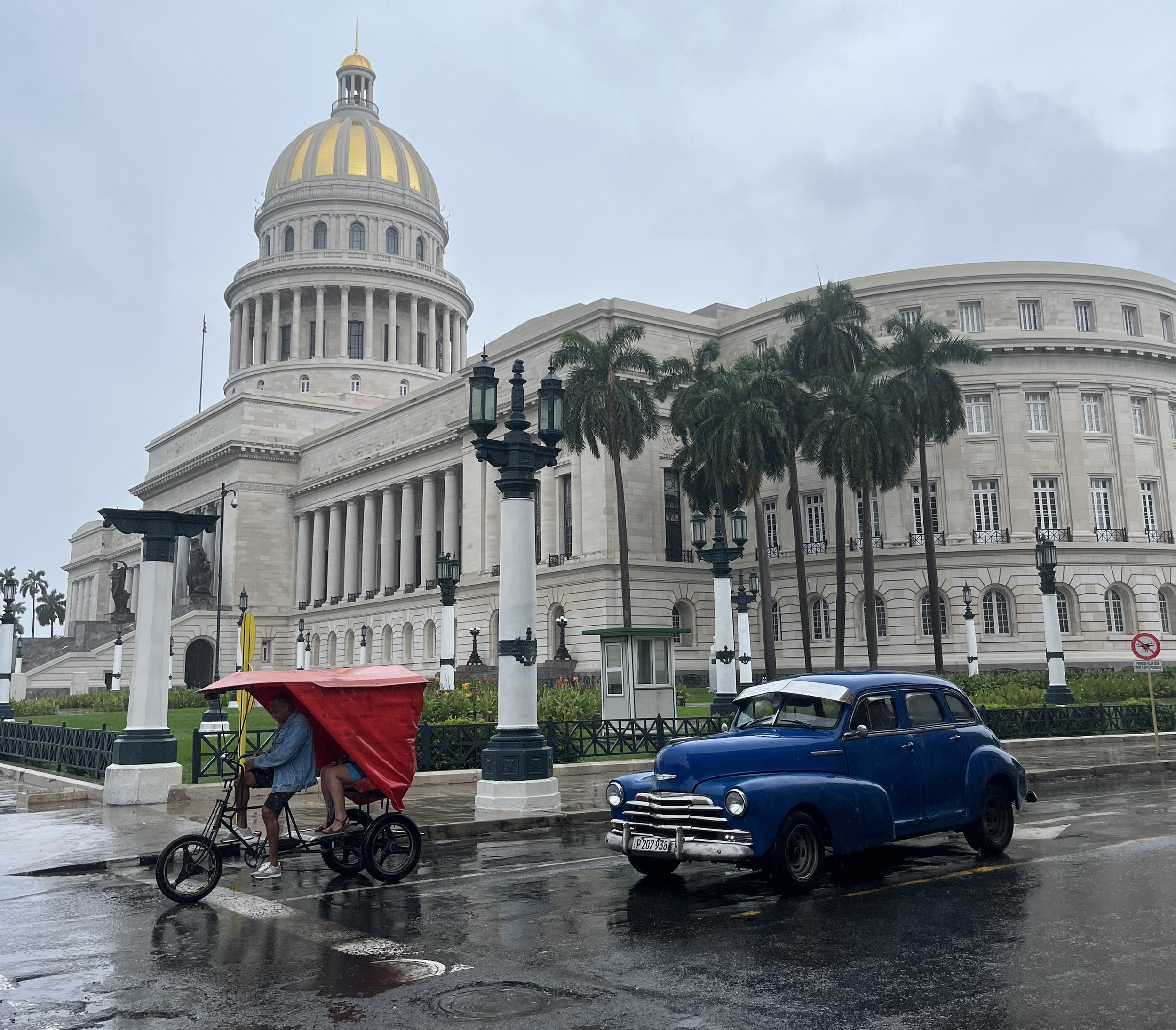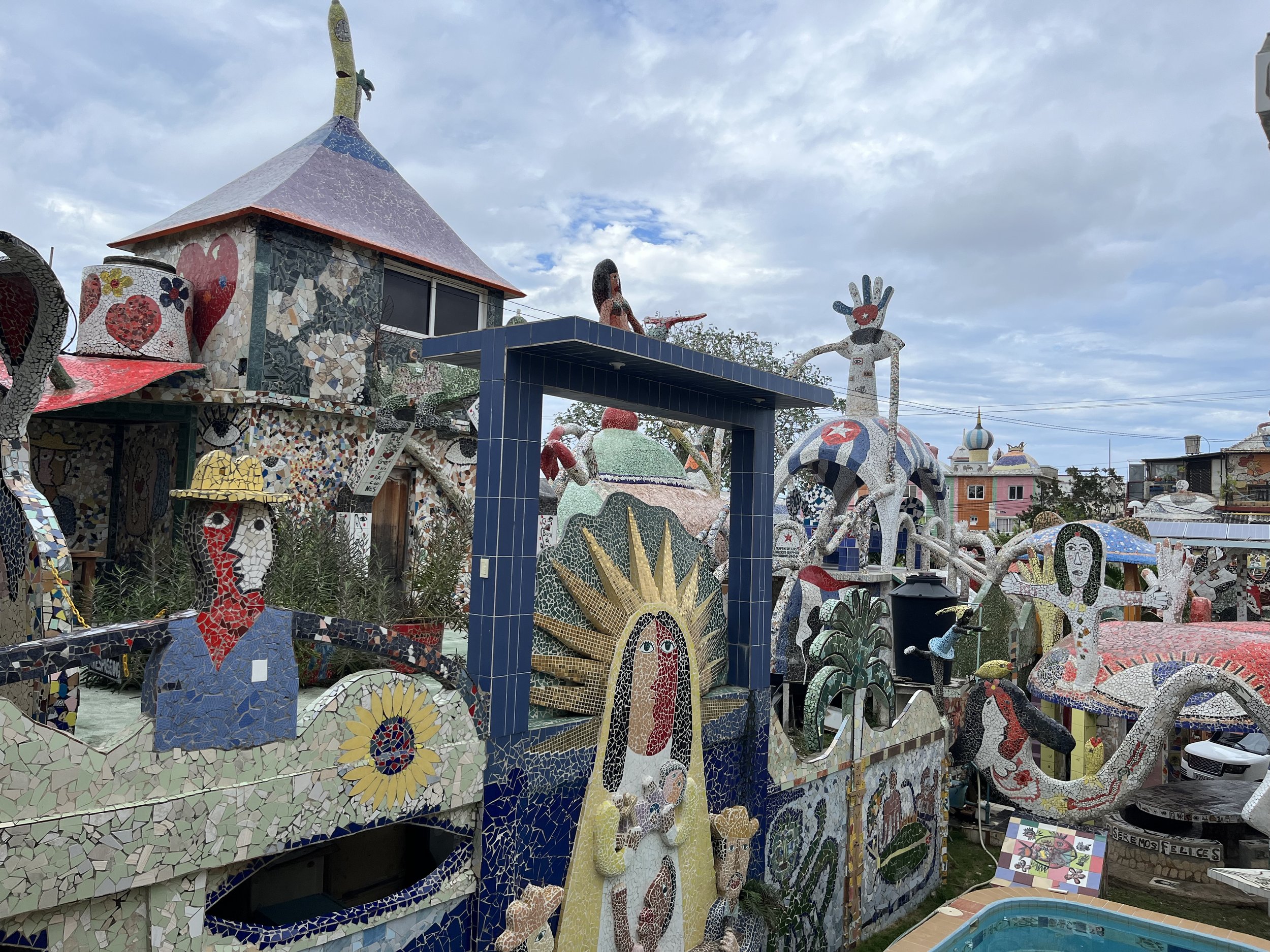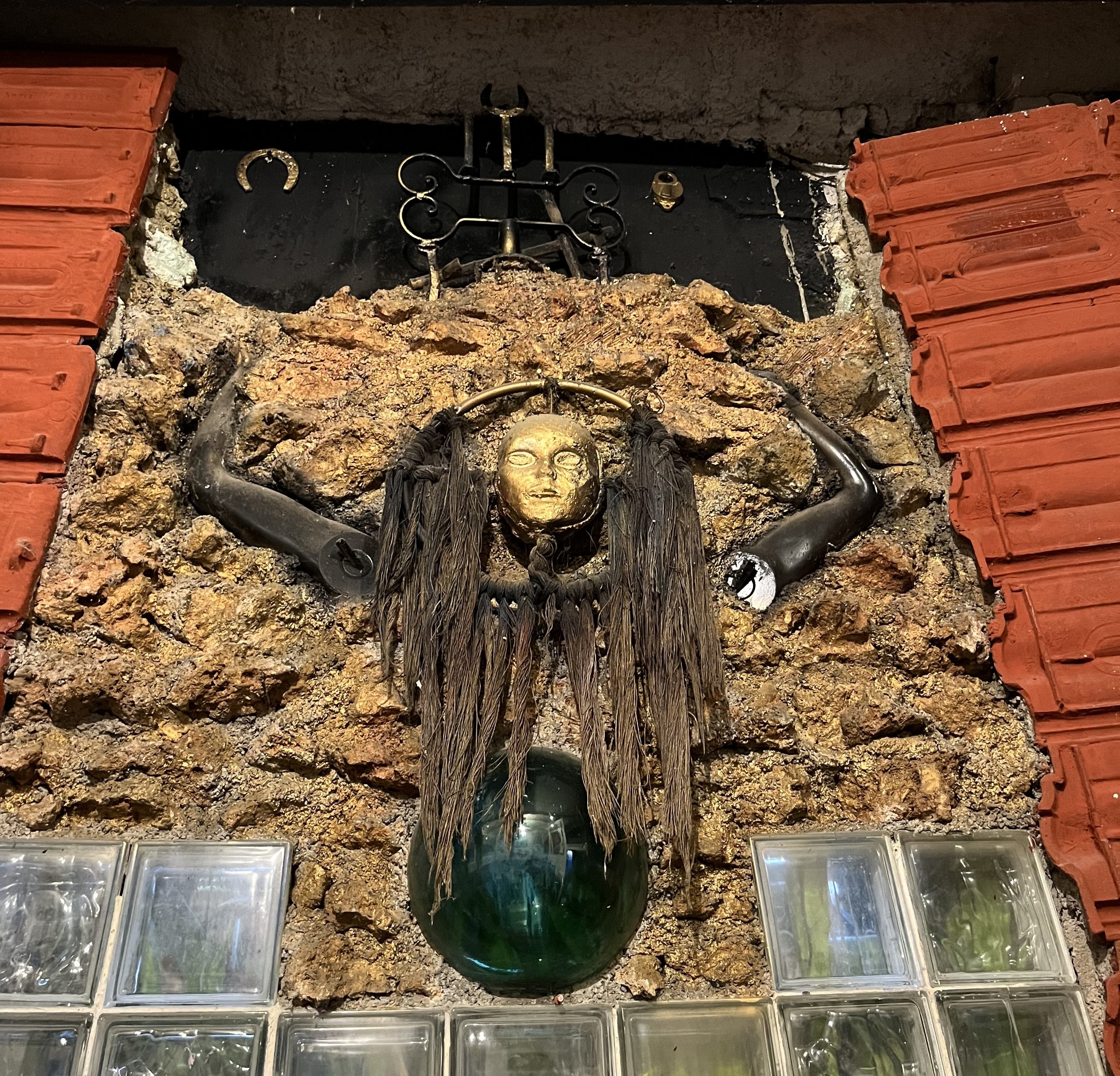🇨🇺 Cuba Leadership Insights: Freedom Comes from Within 🇨🇺
Line of classic cars alongside the Parque Centrale in Havana
We spent 7 days over New Years in Cuba and I’m blown away by the experiences and people in this complicated country. It’s a juxtaposition of complex political leaders from the US-backed dictator Fulgencio Batista in the 1950s (hence the abundance of classic American cars) to the Cuban revolution with Che Guevara and the Communist reign of Fidel Castro to today’s inflation-plagued post-Castro survival mode.
And through all this, I was struck by the ingenuity of all the hardworking, optimistic people we met, each determined to forge their own paths for their families despite being seemingly trapped in a corrupt, chaotic system of bizarro rules and rampant inflation.
For some of them, it was clear that freedom comes from within. Each person still had individual choice to make.
In a socialist system, the base of Maslow’s hierarchy of needs is met. With our mixture of poorly spoken Spanish and their English learned from watching movies, we tried to understand both the system and the Cuban people. Everyone has free housing (if it’s available), free education through university, and weekly or monthly rations of basic food like rice, beans, and eggs as well as petrol for official taxi drivers.
There’s enough to sustain a life but maybe just barely. Freedom comes from individual choice on the upper levels of the hierarchy of needs.
I’m still pondering so many life and leadership lessons from this experience. Many of us with good jobs, capitalist markets, and the fortune to live in a powerful democracy have a lot to learn. We feel our freedom is taken away when we’re laid off or our managers can’t fulfill the promises of raises or promotions we feel that our hard work is owed. We feel restricted when we have to compromise individual needs to please what the people we love truly desire.
We can’t always change the system (though many of us can keep fighting for equity!) yet we can understand it and our place within it. And we can always make individual choices. That is freedom.
These are five parts of the Cuban lessons that apply to leadership and my own growth journey:
Understanding the System
Freedom of Entrepreneurship
Freedom of Creativity
Freedom of Spirit
Freedom of Contentment
1. Understanding the System
I don’t profess to even have more than a surface understanding of the complex history and current political situation in Cuba. I’ve done some reading, and while I’ve been eager to get the first person perspective of all the people we’ve met, it’s been challenging with my limited Spanish, their English-learned-from-watching-movies, and the natural caution and hesitation of sharing too much with a transient tourist. Mostly, people will nod, smile, say “it’s complicated” and then move on to a different topic.
The Capitol in Havana juxtaposed between bicycle taxi and a classic car
In Havana, we were first surprised to see their Capitol as a replica of the US Capitol. Our taxi driver alluded to the fact that the American government supported the Bautista dictatorship. We were surrounded by relics of the American “friendship” that had US ownership of much of the country’s resources ranging from sugercane to tobacco. It felt like half the cars on the road were exquisitely-maintained American classics. Luxury hotels and bars had photos of American mobsters and 50s movie stars. One breakfast place had tables with legs made from the bases of old Singer sewing machines. Another Iranian restaurant had a wall of antique typewriters. Everything was reused, which we assume is because of the scarcity of imports.
Beautiful decor — note the table legs— at Cafe Arcangel
Anique typewriters and cameras at Iranian cafe Topoly
On the streets, we were constantly approached by people asking if we wanted to change money. Several years ago, the government phased out their CUC (Cuban Convertible Peso) which was pegged to the dollar and moved to a single CUP (Cuban peso). In the last year, the Cuban peso’s value has plunged drastically. An ice cream bar which cost me 500 pesos (about 2 USD on the black market) would have cost 200 pesos a year ago.
Most of the store shelves were bare. When one of our drivers saw several pints of ice cream for sale at a gas station store, he bought one for his 3 year old daughter despite being a 1.5 hour drive away. Her reaction upon receiving it was pure joy!
Our taxi driver in Havana told us that the previous day, he got in line for gas at 9am. He finally was able to fill his tank at 4pm. At the few gas stations that had received a precious delivery, we saw lines of cars stretching 3–4 blocks long for gas.
Our driver from Havana to Vinales had a stash of fuel squirreled away to make our 3 hour drive possible
Even on the main highways, you’d see horse transport on the shoulders as the most accessible way of inter-city travel with the fuel shortage. (and no, this picture wasn’t taken on the highway)
This is a hard life. It’s gotten worst since the pandemic. Everyone has a different theory — fewer tourists visiting (with their inflation-proof dollars or euros), the corrupt or inept government, or perhaps the US embargo. The consensus that things have gone downhill since the Trump administration. Popular opinion is that everyone loves Obama, thinks Trump is loco, and looks at Biden as an old compromiser who won’t help them but won’t make things worse.
Everywhere we went, people assured us that while they don’t like the American government, they have nothing but love for the American people.
As an aside, many people have asked us how we were able to travel to Cuba as Americans. There are direct flights from Houston and Miami. You don’t need to go through a tour. You simply need to self-attest the purpose of your visit — most people select the option of “supporting the Cuban people.” We got a visa on demand for around $75 at the Houston airport. There’s a list of banned government-owned hotels which we avoided by using AirBnb to book home stays at people’s casa particulares. The biggest inconvenience was not having access to the US banking system or ATM cards, so we carried all the cash we needed for the trip. This wasn’t a concern for travelers from any other nation — their credit cards and ATM cards (when there was cash) worked just fine.
The system is complicated. Understanding the system helps provide context, history, and gives me empathy to what each ordinary person is doing to survive and find personal contentment.
In Cuba, we encountered so much inspiration and examples of individuals making countless personal choices and choose freedom. They could exercise this choice even within the restrictions of their Marxist–Leninist one-party socialist island-state with the Communist Party written into the constitution.
2. Freedom of Entrepreneurship
People were endlessly willing to talk about money. I suppose the price of goods and services must be on the forefront of one’s mind to survive in such rampant inflation. Most of the English speakers we met were well educated, with degrees in a variety of subjects ranging from Mechanical Engineering to Philosophy to Cybertechnology. One was making a living as a bike mechanic and gaining a bit of extra money from us as he played impromptu tour guide to his neighborhood. Our Havana home stay hosts had a daughter finishing up medical school. Once she’s done, she’ll make $30 US a month. One of our other guides had a brother-in-law who’s a doctor and is currently stationed in Africa with an organization similar to Doctors Without Borders — the Cuban education system is top notch, but there’s not much of a living to be made in the country.
By far the most lucrative industry is tourism. Not only was our nightly AirBnB rate in Havana around $35 (on the lowest end) but tourists also bring in a stable currency.
In the farming village of Vinales, we met a tobacco farmer and cigar expert. He’s required to sell 90% of his crop to the government. Yet he’s learned enough English to become a tour guide, sharing the fascinating process of tobacco growth, picking and drying, and educating us on the various parts of the plant. We learned that the strongest cigars, the Cohiba brand, comes from the top & most potent part of the plant; the next strongest is Montecristo from the middle leaves; and the mildest from the bottom comprises a range of brands including Romeo y Julieta. He makes a livelihood from tourism and selling his 10% crop. It’s a high value exchange for us: we learned so much about the process as well as how to roll a cigar by hand. And he proudly says that his cigars are “100% organico,” so pure — and because he removes the most addictive nicotine core — that they can be inhaled unlike the chemically treated commercial cigars from any factory.
Enjoying a cigar with the tobacco entrepreneur
Our AirBnB host Mariela was endlessly gracious. She and her mother made us a home cooked meal every morning, scouring the shops and hoarding a little bit of flour to bake us pancake balls or biscuits in addition to home-made jam. She took care of every part of the stay from restaurant recommendations, to our horse tour of the tobacco farm, to procuring mountain bikes for us to independently explore. Being part of the tourist trade gives people the most freedom of entrepreneurship.
Mariela’s husband Pacho is a chef at the state run restaurant down the street. Also, getting a kid passing by the house to take a photo will often result in his thumb selfie.
3. Freedom of Creativity
The biggest surprise of our trip was the richness of the art scene in Havana. All around us the streets had gorgeous unique street art and graffiti murals. We visited an homage of Gaudi’s work at Fusterlandia where artist Jose Fuster had painstakingly recreated his neighborhood as a mini Barcelona in colorful surreal mosaic.
At Fusterlandia with the Cuban flag mosaic
More Gaudi homage at Fusterlandia
We also went to one of the most spectacular art experiences that I’ve ever seen. It would be at home in Manhattan or Berlin or Tokyo. The Fabrica de Arte Cubano is a massive 3 story building only open on weekend nights that’s a combo of a modern art gallery, sculpture garden, live music venue, and disco. Some of the art was sexually explicit and drop-dead gorgeous. We saw a solo pianist warble Beatles songs and danced with a crowd going wild for 3 Cuban rappers. Small food stalls and bars were spread throughout the space. We were surrounded by curious tourists and wealthy locals seeking the richness of the city’s nightlife.
Art at Fabrica de Arte Cubano
Sculpture and moon at Fabrica de Arte Cubano
Art at Fabrica de Arte Cubano (not sharing our posed picture in front of this piece :p)
We visited numerous art galleries and studios in Havana, trying to have conversations with the artists. One memorable evening had us invited back to a private tango costume party at the artist’s studio! We couldn’t communicate much with anyone, but the dancing was fabulous.
We bought some art at Elojo de Cicion run by the artist Leo D’Lazaro
The artist Leo D’Lazaro at Elojo de Cicion, his studio / museum / tango party
We conjectured that the socialist system of having free studio space, education, and some level of rationed food left plenty of time for freedom of creativity. Artists and musician were free to pursue their creative endeavors. As we walked around Havana Vieja, music wafted out from all the bars and restaurants. I’d never felt such a festive street atmosphere — it reminded me of New Orleans or Salvador in Brazil. I was grateful for my first small taste of Caribbean culture.
Even within the system, many people were making choices for their art and creative pursuits.
4. Freedom of Spirit
I was delighted to learn about a unique underground Afro-Cuban religion known as Santeria. While many folks are practicing Catholics that go to mass, they also believe in a spiritual tradition with its own orishas and deities, that reminded me of voodoo practices in New Orleans. Santeria, with roots from the African slave trade, had to go underground when forbidden in the Communist regime. Many of the orishas were known by two names. For example, Chango the powerful masculine orisha of lightening and fire, is also known as Santa Barbara. I believe this altar ego was Chango’s cover-up name and gender-fluid disguise, so that Santeria followers could continue their freedom of spiritual worship.
As we walked through a pleasant park in Havana Vieja, we saw a dead rooster sacrificed at the base of a sacred ceiba tree, a brief glimpse into the aftermath of a Santeria ritual. We also visited Callejon De Hamel, an artist’s rendition of Santeria-as-art. Our local guide (the philosopher turned bike mechanic from above) explained that while a Santeria church wouldn’t have have been allowed, this street could flourish as an artist enclave. Sadly, we didn’t visit on Sunday when it turns into a rumba street party, drawing in many visitors.
My bruja (witch) was delighted to see the freedom of spirit covertly practiced within the system.
Santeria art in Callejon de Hamel
5. Freedom of Contentment
Given that we were in an island nation screwed over by global superpowers and military dictators, I would have expected to meet people in despair and fighting against their confinement. And don’t get me wrong, this does exist, as shown by the desperate exodus of Cuban immigrants making their way by boat or overland through central America to some type of freedom…. but that wasn’t our (rose-tinted) experience of Cuba.
Instead, the people we interacted with — all beneficiaries of tourism — seemed content with their entrepreneurial choices. Yes things were hard, yes it’s complicated, but most of them didn’t want to leave. This was their home and the hope is that next year will be better.
As we wound our way on horseback through the peaceful farms of the Vinales valley, taking turns singing songs in Spanish and English, I realized that our horseback guide Jesus was very content, or tranquillo as he put it. He had everything he wanted. He had a family farm that produced plenty of vegetables which he could trade with his neighbors (but not sell as that would require a different government license). That night, New Years Eve, friends and family would gather around a celebratory roast pig. He was wicked smart in his observations and enjoyed practicing English with us. He’d been to Havana a couple of times, but it was too busy. Life was good. Tranquillo.
I figured that overall, he had a freedom of contentment that I was still lacking in my busy, tech-filled San Francisco life.
A tranquillo life in Vinales
Cuba was an amazing experience for us. It gave me so many lessons in trying to understand such a different system and realizing that ultimately, freedom comes from within. Even within this complicated system, we all continue to have individual choices.
The complicated juxtaposition of delighted tourists and weary driver outside the Hotel Nacionale

















